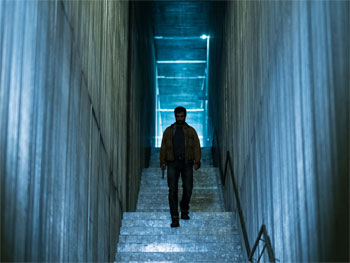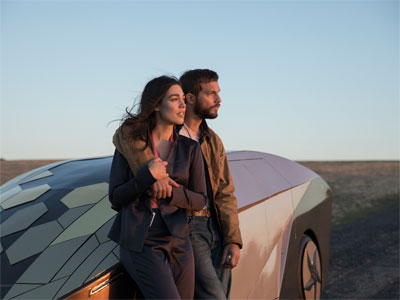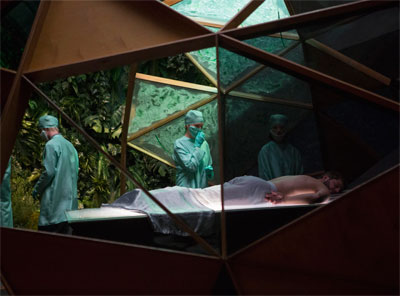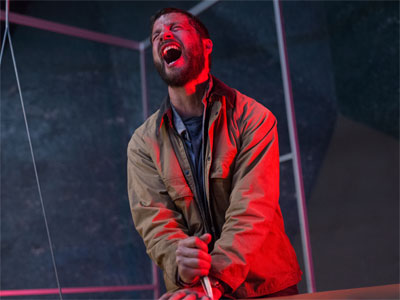Logan Marshall Green Upgrade

Written and directed by Leigh Whannel, writer of the Saw.
Cast: Logan Marshall-Green, Richard Anastasios, Rosco Campbell
Director: Leigh Whannell
Genre: Action, Comedy, Horror
Rated: MA 15+
Running Time: 100 minutes
Synopsis: Upgrade is a thrilling vision of the future from Leigh Whannell, the creator of Saw and Insidious, the US producers of Get Out and The Purge, and the Australian producers of Cleverman.
After his wife is killed during a brutal mugging that also leaves him paralysed, Grey Trace (Logan Marshall Green, Spider-Man: Homecoming, Prometheus) is approached by a billionaire inventor with an experimental cure that will 'upgrade" his body. The cure - an Artificial Intelligence implant called STEM - gives Grey physical abilities beyond anything experienced and the ability to relentlessly claim vengeance against those who murdered his wife and left him for dead .
Upgrade
Release Date: June 14th, 2018
 Director's Statement
Director's Statement
Sometime after Insidious, it became my goal to make a sci-fi film that had the creative freedom of an independent film whilst also making it feel like a big and expansive world. Around this time, I had an idea about a quadriplegic man who was controlled by a computer. And that is when Upgrade was born, but I hadn't planned to direct it. It was attached to another director but after I directed my first film – Insidous: Chapter 3 and everyone asked 'What is next?" I thought 'What about Upgrade?". I asked the director that it was attached to if I could take it back and he kindly said yes. It felt like it was all meant to happen.
My influences during the writing of Upgrade were films like The Terminator – a perfect example of a relatively low budget independent film that feels much bigger than it is. Besides being brilliantly written and directed by James Cameron, the film pulled off an amazing sleight of hand. Arnold Schwarzenegger played the murderous robot so well that you really believed he was a cyborg under that flesh. He IS the special effect in that movie. And this is something I wanted to do with Upgrade.
The 1980's were, in my opinion, a great time for science fiction films because they were the height of practical effects. When the 90s arrived, and with them ground breaking CGI films like Jurassic Park and - ironically - Terminator 2, the era of practical, handmade effects became much more quiet. What I miss about that style though, is that the science and the fiction had to live within a box. You couldn't conjure up anything the way a computer can, so you had to get creative. This made films like Robocop, The Thing, Scanners, Total Recall and many more of that era my inspirations for Upgrade. I didn't want to simply pay homage to them - I wanted to write a story about thoroughly modern themes in the spirit of those movies. Something tactile and grimy. Something audiences could see themselves in.
I knew I needed a lead actor who would dedicate himself completely to the physical aspect of the main character, because one of the big special effects is just the actor using his body. In this respect, I am thankful to the almighty Movie Gods for helping me find Logan Marshall-Green. He is not only a brilliant actor who captured the emotional turmoil of the character, but he trained for months on his own time to be able to pull of the robotic, computerized movement I wanted him to enact for the camera.
The rest of the casting came from auditions. Betty Gabriel blew me away with her audition. She really reached through the screen. I instantly could tell that she could play the role of Cortez. She delivers all the time, on time. For the role of Stem, I only wanted to hear the audio from the auditions and Simon Maiden's voice was exactly what I imagined when I was writing it. He had this really good interplay with Logan and I thought that they were great partners as actors.
 Making the Film in Australia
Making the Film in Australia
Once we decided to shoot the film in Australia, I insisted on shooting in my hometown of Melbourne. Melbourne has a great gothic, urban feel to it that blends both old and new. It's futuristic and forward looking whilst also housing imposing Victorian architecture. This mix is exactly what I wanted.
With Kylie du Fresne at Goalpost Pictures, we assembled a talented and dedicated crew in Melbourne and couldn't have realized this world without them. Including pre-production, the production took about 3-4 months. It wasn't a long shoot due to the smaller budget, but the key to victory was a lot of planning.
Australian Cinematographer, Stefan Duscio was a great partner. For the fight scenes, we really wanted that feeling of computer precision and so we actually locked the camera to the actors in the scenes. It gave us this really precise movement that added to the feeling of an artificial intelligence being in control.
I worked really closely with Felicity Abbott, the production designer. She never worked on a movie like this before – which was a huge bonus since I wanted it to feel new and different to the audience. Before production, we had a lot of conversations about the near-future – Alexa, Siri, self-driving cars. However, we wanted it to be touchable and real with nothing too slick or shiny. The film occurs in the near-future, not 100-200 years in the future.
In order to achieve the physical challenges of the role, I paired Logan Marshall Green with an amazing stunt team headed by the legendary Chris Anderson. Chris and his team understood exactly what I was going for with the robotic style of fighting I wanted, and threw themselves into Logan's training with such enthusiasm that it was infectious. Whenever I needed a break from the stresses of pre-production, I would visit the stunt training area we had set up at the Dockland's Studios and immediately start grinning from ear to ear! Fight choreographer Chris Weir designed sequences that went beyond anything I'd seen in films before - and luckily Logan and the other actors were game to learn them. We could not have made the film without the incredible contribution of these stunt performers.
For the other things we did in the film, we did very practically. We had an amazing VFX Company Cutting Edge that gave us all the city scenes, and a prosthetics lead on-set that would create a head that we could just blow up!
After shooting the film, I relocated to Sydney and began editing with Andy Canny. His storysense, thoughtful opinions and total focus were a lifeline for me.
I am very thankful for the creation of this film.
- Leigh Whannell
About The Production
Filming Locations and Design
Upgrade was filmed in Melbourne, Australia, with the assistance of the Victorian Government through Film Victoria. Leigh Whannell was deteremined to bring Upgrade back to his home town to take advantage of the city he knows best and in particular the laneways and architectural diversity of the city that he knew would work so well for this film set in the near future.
Upgrade is a world that exists at the interface of high and low technology. Leigh describes it as a world just around the corner so in terms of the visual style it's a reality that we understand from our contemporary experience with an enhanced view of current technologies rather than a departure from life as we know it.
T
he two sets that were the most significant were the two character environments ─ one was the interior of Grey and Asha Trace's house, and the other was the interior of Eron's mansion which contained his laboratory and work environment. They were built on separate sound stages at Melbourne's Docklands Studios. Felicity Abbott and Leigh decided there should be an inclination toward natural materials, so for the sets at Docklands Studios Felicity referenced rammed earth architecture and drew inspiration from naturally occurring fractals and different kinds of geometry such as webs and nests that are undercurrents rather than being obvious.
Producer Kylie du Fresne says the production found additional locations across Melbourne's suburban environment that had the tone and feel of generic US cities and suburbs, such as a subterranean corridor at RMIT University in the city.
The entrance to Eron's extraordinary house was shot on the Mornington Peninsula, on the coast south east of Melbourne, on a cliff with beautiful sunsets. For the entrance to his world production designer Felicity Abbott built enormous rocks and used DSX ─ Digital Set Extension. There was also a backlot at Collingwood Arts Precinct with various sets, elevators and set pieces including the hacker loft and Serks house. The producers also worked closely with Vic Roads to close a section of the Craigiburn bypass where they filmed the spectacular car chase scene over a number of nights – the first time a feature film had been given approval to close this important road.
Vehicles
Production had a dedicated construction workshop just to build the automated cars and futuristic police vehicles. For one of the automated cars, they built a smaller set of the interior that they shot at Docklands studios. The car exteriors that were then built were actually driven on a road that was blocked off for the shoot. These automated cars were driven by stunt drivers with cameras hidden inside the exterior linked through to a video screen inside the car - much like a video game. This was because there were no windscreens to see out of. On screen it's shown that the driver sees the outside world through cameras and sensors, or they can be making a video phone call or reading email. So there was some complex VFX interaction that required green screen and other elements.
Release Date: June 14th, 2018
MORE
- Mission: Impossible Fallout
- Glenn Close The Wife
- Allison Chhorn Stanley's Mouth Interview
- Benicio Del Toro Sicario: Day of the Soldado
- Dame Judi Dench Tea With The Dames
- Sandra Bullock Ocean's 8
- Chris Pratt Jurassic World: Fallen Kingdom
- Claudia Sangiorgi Dalimore and Michelle Grace...
- Rachel McAdams Disobedience Interview
- Sebastián Lelio and Alessandro Nivola...
- Perri Cummings Trench Interview




